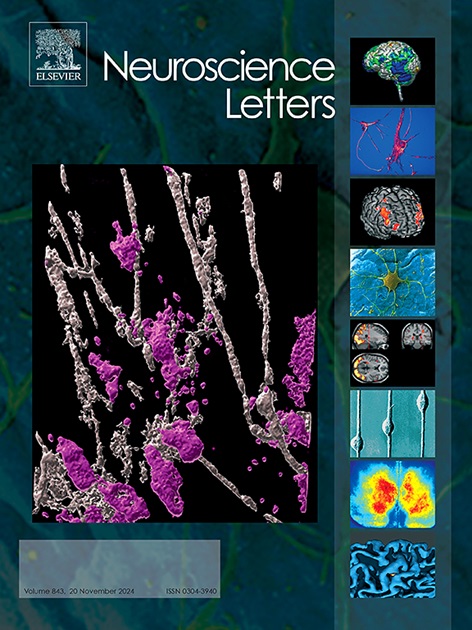A novel prefrontal cortex and hippocampus combined brain slice based on in vivo diffusion tensor imaging of healthy male rats
IF 2
4区 医学
Q3 NEUROSCIENCES
引用次数: 0
Abstract
The pathway between the prefrontal cortex (PFC) and hippocampus (HPC) has been associated with various psychiatric disorders. While hippocampal brain slices are extensively utilized, their use has traditionally been constrained in studying long connectivity between PFC and HPC due to nerve fiber rupture during the slicing process. Consequently, optimizing brain slice preparation is crucial. The experiment consisted of three phases. Initially, the structural connection of the PFC-HPC pathway was examined using diffusion tensor imaging (DTI) data from healthy male rats. Subsequently, combined PFC-HPC brain slices were created through vibratome based on imaging acquisition. Finally, the morphology and electrophysiology of the combined brain slices were analyzed. DTI findings revealed numerous nerve fibers linking the two brain regions in the rat brain. Subsequently, a successful preparation of combined PFC-HPC brain slices cut at a 7 – 8° angle relative to the middle sagittal plane was achieved using a vibratome. Hematoxylin and eosin staining results confirmed that PFC-HPC fibers remained well-preserved in the combined brain slice. Electrophysiological recordings indicated that synchronized neuronal activity occurred in the HPC upon PFC stimulation, which depended on hippocampal activity and the integrity of PFC-to-HPC connectivity. A novel procedure for the successful preparation of healthy combined HPC-PFC brain slices, maintaining a complete fiber bundle connection between PFC and HPC, is proposed. This methodology enhances the understanding of the preservation of PFC-HPC connectivity in specific angled brain slice preparations, thereby facilitating neuroscience research focused on the longrange circuitry of subregions of interest.

基于体内弥散张量成像的健康雄性大鼠前额皮质和海马联合脑切片
前额皮质(PFC)和海马(HPC)之间的通路与多种精神疾病有关。虽然海马体脑切片被广泛使用,但由于切片过程中神经纤维断裂,在研究PFC和HPC之间的长连接时,其使用传统上受到限制。因此,优化脑切片制备是至关重要的。实验分为三个阶段。首先,使用健康雄性大鼠的扩散张量成像(DTI)数据检查PFC-HPC通路的结构连接。随后,基于成像采集,通过振动体构建PFC-HPC联合脑切片。最后对合并脑切片进行形态学和电生理分析。DTI发现,在大鼠的大脑中,有大量的神经纤维连接着这两个大脑区域。随后,使用振动刀成功制备了相对于中矢状面7 - 8°角的PFC-HPC联合脑切片。苏木精和伊红染色结果证实PFC-HPC纤维在合并脑切片中保存完好。电生理记录显示,PFC刺激后,HPC发生同步神经元活动,这取决于海马活动和PFC- HPC连接的完整性。提出了一种成功制备健康HPC-PFC联合脑切片的新方法,保持PFC和HPC之间完整的纤维束连接。这种方法增强了对PFC-HPC连接在特定角度脑切片制备中的保存的理解,从而促进了神经科学研究的重点放在感兴趣的子区域的远程电路上。
本文章由计算机程序翻译,如有差异,请以英文原文为准。
求助全文
约1分钟内获得全文
求助全文
来源期刊

Neuroscience Letters
医学-神经科学
CiteScore
5.20
自引率
0.00%
发文量
408
审稿时长
50 days
期刊介绍:
Neuroscience Letters is devoted to the rapid publication of short, high-quality papers of interest to the broad community of neuroscientists. Only papers which will make a significant addition to the literature in the field will be published. Papers in all areas of neuroscience - molecular, cellular, developmental, systems, behavioral and cognitive, as well as computational - will be considered for publication. Submission of laboratory investigations that shed light on disease mechanisms is encouraged. Special Issues, edited by Guest Editors to cover new and rapidly-moving areas, will include invited mini-reviews. Occasional mini-reviews in especially timely areas will be considered for publication, without invitation, outside of Special Issues; these un-solicited mini-reviews can be submitted without invitation but must be of very high quality. Clinical studies will also be published if they provide new information about organization or actions of the nervous system, or provide new insights into the neurobiology of disease. NSL does not publish case reports.
 求助内容:
求助内容: 应助结果提醒方式:
应助结果提醒方式:


